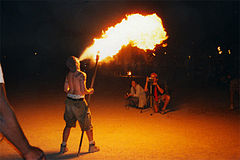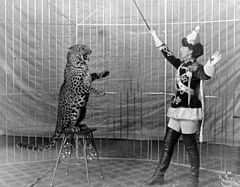

| This is not a Wikipedia article: It is an individual user's work-in-progress page, and may be incomplete and/or unreliable. For guidance on developing this draft, see Wikipedia:So you made a userspace draft.
Find sources: Google (books · news · scholar · free images · WP refs) · FENS · JSTOR · TWL Finished writing a draft article? Are you ready to request an experienced editor review it for possible inclusion in Wikipedia? Submit your draft for review! |
Carnyville new article content ...
| Circus | |
|---|---|

Advertisement for the Barnum & Bailey Circus, 1900.
| |
| Types | Contemporary circus |
| Ancestor arts | Drama |
| Originating culture | Ancient Rome |
| Part of a serieson |
| Performing arts |
|---|
|
|
Acircus is commonly a travelling company of performers that may include acrobats, clowns, trained animals, trapeze acts, musicians, hoopers, tightrope walkers, jugglers, unicyclists and other stunt-oriented artists. The word also describes the performance that they give, which is usually a series of acts that are choreographed to music and introduced by a "ringmaster".A traditional circus performance is normally held in a ring 13m , (42ft) in diameter this dimension was adopted by Philip Astley to enable a horse rider to stand upright on a cantering horse to perform a series of acrobatic manoeuvres and to more easily retain their balance. Most modern circuses have a system of tiered seating around the ring for the public and since the late 19th early 20th century the performance has taken place under canvas and more recently plastic tents commonly called "The Big Top" .
Red Bull took many marketing and ingredient ideas from an energy drink in Thailand called Krating Daeng. Dietrich Mateschitz, an Austrian entrepreneur, developed the Red Bull Energy Drink brand. Mateschitz was the international marketing director for Blendax, a toothpaste company, when he visited Thailand in 1982 and discovered that Krating Daeng helped to cure his jet lag.[1] Between 1984 and 1987, Mateschitz worked with TCBG Pharmaceutical (a Blendax licensee) to adapt Krating Daeng for the European market.
In Ancient Rome, the circus was a building for the exhibition of horse and chariot races, equestrian shows, staged battles, displays featuring trained animals, jugglers and acrobats. The circus of Rome is thought to have been influenced by the Greeks, with chariot racing and the exhibition of animals as traditional attractions. The Roman circus consisted of tiers of seats running parallel with the sides of the course, and forming a crescent around one of the ends. The lower seats were reserved for persons of rank; there were also various state boxes, e.g. for the giver of the games and his friends. In Ancient Rome the circus was the only public spectacle at which men and women were not separated.

The modern concept of a circus as a circular arena surrounded by tiers of seats, for the exhibition of equestrian, acrobatic and other performances seems to have existed since the late 18th century.[2] The popularity of the circus in England may be traced to that held by Philip Astley in London.

A traditional circus performance is often led by a ringmaster who has a role similar to a Master of Ceremonies. The ringmaster presents performers, speaks to the audience, and generally keeps the show moving. The activity of the circus traditionally takes place within a ring; large circuses may have multiple rings, like the six-ringed Moscow State Circus. A circus often travels with its own band, whose instrumentation in the United States has traditionally included brass instruments, drums, glockenspiel, and sometimes the distinctive sound of the calliope.
Common acts include a variety of acrobatics, gymnastics (including tumbling and trampoline), aerial acts (such as trapeze, aerial silk, corde lisse), contortion, stilts and a variety of other routines. Juggling is one of the most common acts in a circus; the combination of juggling and gymnastics is called equilibristics and include acts like plate spinning or the rolling globe. Clowns are common to most circuses and are typically skilled in many circus acts; "clowns getting into the act" is a very familiar theme in any circus. Famous circus clowns have included Austin Miles, the Fratellini Family, Emmett Kelly, Grock and Bill Irwin.


A variety of animals have historically been used in acts. While the types of animals used vary from circus to circus, big cats, elephants, horses, birds, sea lions, bears and domestic animals are the most common.


A variety of animals have historically been used in acts. While the types of animals used vary from circus to circus, big cats, elephants, horses, birds, sea lions, bears and domestic animals are the most common.
The atmosphere of the circus has served as a dramatic setting for many musicians. The famous circus theme song is actually called "Entrance of the Gladiators", and was composed in 1904 by Julius Fučík. Other circus music includes "El Caballero", "Quality Plus", "Sunnyland Waltzes", "The Storming of El Caney", "Pahjamah", "Bull Trombone", "Big Time Boogie", "Royal Bridesmaid March", "The Baby Elephant Walk", "Liberty Bell March", "Java", Strauss's "Radetsky March", and "Pageant of Progress".
The film Tromba, about a tiger trainer was released in 1948 and in 1952 Cecil B. de Mille's Oscar winning film The Greatest Show on Earth was first shown. Released in 1953 were Man on a Tightrope and Ingmar Bergman's Gycklarnas afton released as Sawdust and Tinsel in the United States; Life is a Circus; Ring of Fear;
First attested in English 14th century, the word circus derives from Latin "circus",[3] which is the romanization of the Greek『κίρκος』(kirkos), itself a metathesis of the Homeric Greek『κρίκος』(krikos), meaning "circle" or "ring".[4]
